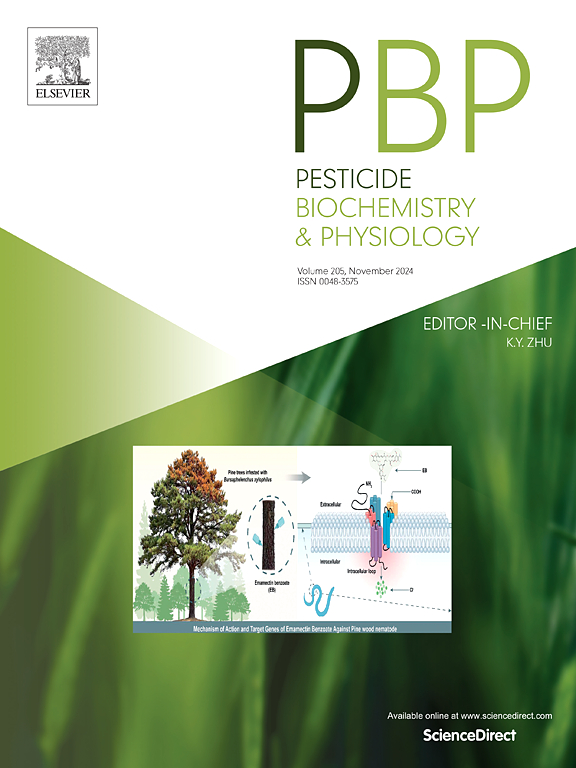基于靶酶对新型HPPD抑制剂氟鲁非南的对体选择性生物活性作用机制进行了研究
IF 4.2
1区 农林科学
Q2 BIOCHEMISTRY & MOLECULAR BIOLOGY
引用次数: 0
摘要
氟磺胺是一种新型手性酰胺类除草剂,广泛用于稻田一年生杂草的防治。然而,其对映体选择性除草活性的机制尚不清楚。本研究发现,与典型HPPD抑制剂美索三酮类似,氟鲁非南对映体降低了叶绿素和类胡萝卜素水平,降低了HPPD酶活性,上调了基因表达。此外,均质剂的补充减轻了氟鲁非南引起的白化症状,这些结果证实了氟鲁非南确实是一种HPPD抑制剂。为了进一步研究对端选择性的机理,我们采用分子对接的方法,发现R-flusulfinam (- 6.55 kcal/mol)比S-flusulfinam (- 5.60 kcal/mol)具有更高的结合能,这是因为R-flusulfinam与Gln293之间的氢键更稳定。将Gln293突变为His后,R-flusulfinam和S-flusulfinam对MutQ293H的IC50值分别为0.73 mg/L和0.11 mg/L,与AtHPPD相比,IC50值分别为0.52 mg/L和1.93 mg/L。微尺度热泳实验进一步表明,MutQ293H与R-flusulfinam的解离常数(Kd)为20.40±4.19 μM,与S-flusulfinam的解离常数(Kd)为15.63±4.51 μM相似。结果表明,AtHPPD酶Gln293残基突变显著改变了氟鲁非南对AtHPPD酶的对端选择性抑制作用。本研究首次验证了氟鲁非南的作用方式,并确定Gln293可能在AtHPPD中对氟鲁非南的对端选择性中发挥关键作用,为未来基于氟鲁非南开发HPPD抑制剂奠定基础。本文章由计算机程序翻译,如有差异,请以英文原文为准。

Basing target enzyme study the enantioselective bioactivity action mechanism of flusulfinam, a novel HPPD inhibitor herbicide
Flusulfinam is a novel chiral amide herbicide widely used for controlling annual weeds in rice paddies. However, the mechanism underlying their enantioselective herbicidal activity remain unclear. Herein, it was found that flusulfinam enantiomers, similar to typical HPPD inhibitor mesotrione, reduced chlorophyll and carotenoid levels, decreased HPPD enzyme activity, and upregulated gene expression. Additionally, homogentisate supplementation alleviated the bleaching symptoms caused by flusulfinam and all these results validate that flusulfinam is indeed an HPPD inhibitor. To further investigate the mechanism of enantioselectivity, molecular docking was used and showed that R-flusulfinam (−6.55 kcal/mol) had higher binding energy than S-flusulfinam (−5.60 kcal/mol), due to more stable hydrogen bonds with Gln293. After mutating Gln293 to His, the IC50 values for R-flusulfinam and S-flusulfinam on MutQ293H were 0.73 mg/L and 0.11 mg/L, respectively, indicating swapped enantioselective inhibition compared to AtHPPD, with IC50 values of 0.52 mg/L and 1.93 mg/L, respectively. The Microscale Thermophoresis assay further revealed that the dissociation constant (Kd) for MutQ293H with R-flusulfinam was 20.40 ± 4.19 μM, similar to the Kd value of 15.63 ± 4.51 μM for S-flusulfinam. The findings reveal that mutation of the Gln293 residue in the AtHPPD enzyme significantly altered its enantioselective inhibition by flusulfinam. This study is the first to verify the mode of action of flusulfinam and identifies that Gln293 may play a key role in flusulfinam enantioselectivity in the AtHPPD, laying the foundation for future HPPD inhibitor development based on flusulfinam.
求助全文
通过发布文献求助,成功后即可免费获取论文全文。
去求助
来源期刊
CiteScore
7.00
自引率
8.50%
发文量
238
审稿时长
4.2 months
期刊介绍:
Pesticide Biochemistry and Physiology publishes original scientific articles pertaining to the mode of action of plant protection agents such as insecticides, fungicides, herbicides, and similar compounds, including nonlethal pest control agents, biosynthesis of pheromones, hormones, and plant resistance agents. Manuscripts may include a biochemical, physiological, or molecular study for an understanding of comparative toxicology or selective toxicity of both target and nontarget organisms. Particular interest will be given to studies on the molecular biology of pest control, toxicology, and pesticide resistance.
Research Areas Emphasized Include the Biochemistry and Physiology of:
• Comparative toxicity
• Mode of action
• Pathophysiology
• Plant growth regulators
• Resistance
• Other effects of pesticides on both parasites and hosts.

 求助内容:
求助内容: 应助结果提醒方式:
应助结果提醒方式:


